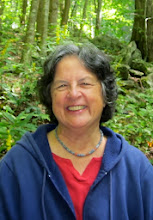 |
| Felicia Florendo, Eastern Band Cherokee, dances at a pow-wow |
Evening, and the thick drone of cicadas blankets our sleep,
punctuated by twitter of titmouse and woodpecker’s call.
This is Snowbird, the redolent Appalachian home
of the ancient Cherokee, four thousand years here,
Kituah, and home still to this Eastern band,
escaped from forced relocation, the Trail of Tears,
and hidden away.
This air, this mystery,
mountains so old, each stone a book,
and this Cherokee spirit everywhere,
matriarchal home of the clans:
The Deer, the Wolf, the Bird,
Wild Potato, Red Paint, Blue Paint, the Twister.
Here still, the native speakers, knowers of the old ways,
medicine keepers.
Who danced here, who dances still,
who finds the bloodroot and the sassafras,
a plant for every illness, as was told?
The tears of the Ancestors nourish each step.
This fresh creek, cold as January on this August day,
places me in that ancient era
when bird and bug and bear and I were one.
Cherokee! I give thanks
that your spirit suffuses this place still,
your love, your surefooted knowing,
your oneness with this mountainous Motherland,
our home, thank you! Our home.
Annelinde Metzner
Santeetlah Creek
Snowbird Cherokee
Snowbird is different from other Cherokee communities, and the absence of tourism is only one way in which Snowbird is different. Most studies of the Eastern Band have focused upon the traditionalist Big Cove community of the Qualla Boundary. Yet, Snowbird has a higher percentage of both fullbloods and Cherokee-language speakers than Big Cove or any other Eastern Cherokee community. Snowbird also has a high percentage of native craftsmen and some Indian doctors with a knowledge of medicinal plant. The reservation lands are scattered into individual tracts of land along Snowbird, Little Snowbird, and Buffalo creeks, not consolidated into a huge land mass like the Qualla Boundary.
The Snowbird Cherokee Indian population of Graham County, about 380 people in 1980, has ancient origins, as does the rest of the Eastern Cherokee population. The Cherokees have probably been native to the southern Appalachians for at least four thousand years.* By the beginning of the historic period, the Cherokees numbered more than 20 thousand them one of the largest Indian nations in North America north of Mexico. They lived on land or held hunting territory in modern states: Alabama, Georgia, Tennessee, Kentucky, Mississippi, the Carolinas, and the Virginias. The mountain and hill country offered varied resources for subsistence, and the Cherokees, through cultivation of corn, beans, squash, pumpkins, and other crops, as well as gathering, fishing, and hunting, achieved a highly successful generalized adaptation.
In an aboriginal Cherokee town, sweathouses, gardens, and rectangular, gabled, wattle-and-daub homes clustered around a square ground. On the west side of the square ground stood a council house, legendarily seven-sided, on a small temple mound. If the town were on the fringes of the Cherokee territory, it was probably surrounded by a stockade as protection from enemy warriors. The household was the basic unit of Cherokee social organization. As was typical of southeastern Indians, residence was matrilocal; thus a newly married couple lived with the wife's family. Legendarily there had always been seven matrilineal clans: the Deer, Wolf, Bird, Wild Potato, Red Paint, Blue Plant, and Long Hair or Twister. From the individual's perspective, 4 of the clans were most important: one's own (which was also one's mother's and maternal grandmother's), one's father's (which was also one's paternal grandmother's), and each of one's grandfathers'. While many people today on the main reservation are not aware of their clan affiliation, most Snowbird Cherokees are.
Cherokee religious and ceremonial life centered around seven festivals, many of them reflecting the interest in the annual cycle of farming. One of these festivals, the Green Corn Ceremony, persisted into the early twentieth century. Seven was a magic number to the Cherokees as evidenced by their seven ceremonies, seven clans, seven-sided council houses, and the seven sacred directions (north, south, east, west, up, down, and here). Anthrocivitas post by Starbuck, 12-02-2010
 |
| Santeetlah Creek |

No comments:
Post a Comment
Your comments are welcome!